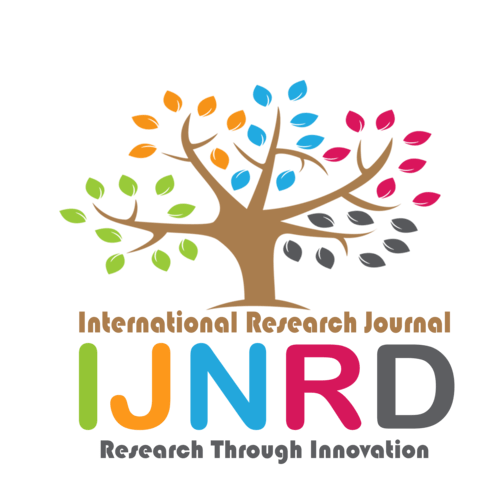|
|||||||||||||||

|
INTERNATIONAL JOURNAL OF NOVEL RESEARCH AND DEVELOPMENT International Peer Reviewed & Refereed Journals, Open Access Journal ISSN Approved Journal No: 2456-4184 | Impact factor: 8.76 | ESTD Year: 2016 Scholarly open access journals, Peer-reviewed, and Refereed Journals, Impact factor 8.76 (Calculate by google scholar and Semantic Scholar | AI-Powered Research Tool) , Multidisciplinary, Monthly, Indexing in all major database & Metadata, Citation Generator, Digital Object Identifier(DOI) |
||||||||||||||
Issue: April 2024
Volume 9 | Issue 4
Review Result and Publication of Paper within : 2-3 days
Click Here For more DetailsFor Authors
Forms / Download
Published Issue Details
Editorial Board
Other IMP Links
Facts & Figure
Impact Factor : 8.76
Issue per Year : 12
Volume Published : 9
Issue Published : 95
Article Submitted :
Article Published :
Total Authors :
Total Reviewer :
Total Countries :
Indexing Partner
Join RMS/Earn 300
Licence
This work is licensed under a Creative Commons Attribution-NonCommercial 4.0 International License







|
Published Paper Details
|
|
| Paper Title: | “A study to assess the effectiveness of structure teaching programme on knowledge regarding polycystic ovarian disease (PCOD ) among adolescent girls in selected schools of Indore (M.P.) |
| Authors Name: | Ms.Shivani Bhadouriya |
| Download E-Certificate: | Download |
| Author Reg. ID: |
IJNRD_198303
|
| Published Paper Id: | IJNRDTH00046 |
| Published In: | Volume 8 Issue 6, June-2023 |
| DOI: | |
| Abstract: | ABSTRACT BACKGROUND AND OBJECTIVES Gynecological problems of adolescents occupy a special space in the spectrum of gynecological disorders of all ages. This is because of the physical nature of the problems, which are so unique, special, and specific for the age group, and because of the associated and psychological factors, which are very important in the growth and psychological remodeling of someone in the transition between childhood and womanhood. Gynecological diseases are common but most of us women ignore the symptoms or we are unaware, until the time the problem really worsens. One of them, now days faced by girls, is POLYCYSTIC OVARIAN DISEASE (Stein leventhal Syndrome). This is the commonest course of Amenorrhea in young girls. Stein and Leventhal first described the Amenorrhea with polycystic ovaries in 1935. PCOS, also known as Polycystic Ovarian Syndrome, is reported to be a Grow problem with adolescent girls. It can be very difficult to diagnose PCOD in teenage girls as they often experience irregular or absent menses and acne. THE OBJECTIVES OF THE STUDY ARE: 1. To assess the pre-test knowledge score regarding (PCOD) among adolescents girls. 2. To assess the post test knowledge score regarding PCOD among adolescents girls. 3. To determine the effectiveness of structure teaching programme regarding PCOD in terms of knowledge score among adolescents girls. 4. To find the association between pretest knowledge score with the selected demographic variables . Conceptual framework is a theoretical approach .To study of problems that are scientifically based and emphasizes the selection and clarification of its concepts. Interrelated concepts or obstructions that are assembled together in some rational scheme by virtue of their relevance to a common theme are rethreaded to as conceptual framework (Polite and Hungler 2005). Finally, conceptual frame work sever as a guide to a systematically identifying logical, precisely defined relationship among variables (Potter & Perry 2005). The present study aimed at assessing effectiveness of structure teaching programme on knowledge of adolescence girls regarding the PCOD, it aim to improve the knowledge of adolescence girls. Methods A structured test was prepared for assessment of knowledge of adolescent girls regarding PCOD. It will be based on literature extracted from journals, books, research, report & personal experience & expert guidance. The tools used in the study are: Section 1: Socio-demographic variables. Section 2: Structured knowledge questionnaire. Results The findings of the present study are discussed with reference to the objective, hypotheses and the finding of other studies. Discussion of finding is based on the sample characteristics, knowledge and among adolescent girls regarding PCOD, effective structure teaching programme, association of knowledge and selected variables. Association between knowledge and selected demographic variable The chi square computed between pre test knowledge score and selected demographic variables should that there is no significant association between the level of knowledge scores and selected demographic variables with regard to age in year (15-17 year), no. of female family members, religion, type of family, family monthly income, education of mother, and source of information. Thus association between knowledge and selected demographic variables is non significant hence hypotheses (2)is rejected Frequency and percentage distribution of sample characteristics and demographic variables In the present study demographic characteristics of among adolescents girls are discussed by age, no. of female family members, religion, type of family, family monthly income, education of mother, and source of information. There was age distribution of subjects adolescent girls age 7(13%), belong below 13 years of age, 15 (37%) belong in 14-15 years of age, 13(33%) belong 16-17 year age, 5(13%) belong 18 and above year of age. Regarding the number of female family members, 10 subjects (25%) have only 1 female family member, 14 subjects (35%) have 2 female family members, 7 subjects (20%) have 3 female 9 subjects (30%) have more than 3 female family members. Most of subject 32(87%) belong to Hindu religion, 3(5%) to Christian, 5(5%) to Muslim, 0 (%) to other respectively. The majority of subject belongs to Hindu religion. Regarding to type of family 27 subjects (67%) lives in nuclear family, 12 subjects (30%) lives in joint, 1 subject (03%) to extended, 0 subjects (0%) lives to other family member respectively. Regarding the family income, 5subjects(12%) has 3000 to 5000 as their family income, 14 subjects (35%) has 5000 to 7000 their family Income,17 subjects (43%) has 7000 to 10000 as their family income 4 subjects (10%)has family income abov10000 . Regarding education of mother, 29 subjects (73%) mothers were illiterate, 15 subjects (20%) mothers were educated upto primary level,08 subject (7%) mothers were educated upto secondary level 4(10%) mothers were graduated. Regarding to information 14subjects ((35%) to family members,10 subjects (25%) to peers, 12 subjects( 30%) to mass media 4 subjects (10%) health personnel are source of information. Family members are higher % of source of information respectively. FEQUENCY AND PERCENTAGE DISTRIBUTION OF PRETEST AMD POST KNOWLEDGE SCORE That maximum knowledge score regarding PCOD, of pre-test were 67% (27) between 0-8 poor knowledge score &33% (13) between 9-16 average knowledge score & in post-test knowledge score were 100% (40) between 17-24 good knowledge score. COMPARISON OF MEAN PRETEST AND POST TEST KNOWLEDGE SCORE: That the mean post-test knowledge score (18.57) is apparently higher than the mean pre-test knowledge score (08). Above table 03 shows, that statistically there was significant difference in knowledge score of PCOD of the students in selected school of Indore. The calculated values are compared and paired’ test is applied at 0.05 level of significant. The tabulated “t” value for 39 degree of freedom is 2.023 and calculated “t” value 20.12 level of significant. Hypothesis was tested by using paired “t” test. The “t” was calculated to analysis the score of PCOD of the students in school of Indore with their pre-test and post-test score. The research hypothesis was formulated to evaluate a study to assess the effectiveness of structure teaching programme on knowledge regarding polycystic ovarian disease (PCOD) among adolescent girls in selected schools of Indore (M.P.) ASSOCIATION BETWEEN LEVEL OF PRETEST KNOLWLEDGE AND SELECTED DEMOGRAPHICAL VARIABLE 1. The association between the demographic variable age with knowledge score grading. The chi-square value obtained is 6.11 with a degree of freedom of 3. P value obtained is >0.05, which is statistically not significant. Thus, there is no association between age and knowledge score grading, showing that age does not affect the knowledge score grading. 2. The association between the demographic variable no. of female family member with knowledge score grading. The chi-square value obtained is 1.45 with a degree of freedom of 3. P value obtained is >0.05, which is statistically not significant. Thus, there is no association between age and knowledge score grading, showing that no. of female family member does not affect the knowledge score grading. 3. The association between the demographic variable religion with knowledge score grading. The chi-square value obtained is 5.85 with a degree of freedom of 2. P value obtained is >0.05, which is statistically not significant. Thus, there is no association between age and knowledge score grading, showing that religion does not affect the knowledge score grading. 4. The association between the demographic variable type of family with knowledge score grading. The chi-square value obtained is 1.41with a degree of freedom of 2. P value obtained is >0.05, which is statistically not significant. Thus, there is no association between age and knowledge score grading, showing that type of family does not affect the knowledge score grading. 5. The association between the demographic variable family monthly incomes with knowledge score grading. The chi-square value obtained is 1.40 with a degree of freedom of 3. P value obtained is >0.05, which is statistically not significant. Thus, there is no association between age and knowledge score grading, showing that family monthly income does not affect the knowledge score grading. 6. The association between the demographic variable educations of mother with knowledge score grading. The chi-square value obtained is 3.44 with a degree of freedom of 2. P value obtained is >0.05, which is statistically not significant. Thus, there is no association between age and knowledge score grading, showing that education of mother does not affect the knowledge score grading. 7. The association between the demographic variable sources of information with knowledge score grading. The chi-square value obtained is 0.62 with a degree of freedom of 3. P value obtained is >0.05, which is statistically not significant. Thus, there is no association between age and knowledge score grading, showing that source of information does not affect the knowledge score grading.. Interpretation and Conclusion The aim of the this study was to assess the knowledge of adolescent girls on PCOD the information was given with the aid of STP which included various aspects menarche and menstruation, dysmenorrheal amenorrhea duration of menstruation cycle which will help the adolescent girls to improve their knowledge and to adopt – a healthy lifestyle . The following conclusion were draw based on the present study, • PCOD are the commonest problem among the adolescent girls. • Dysmenorrhea is one of the leading causes for absenteeism • The knowledge of the adolescent girls was not up to the mark before the introduction of STP. • After the introduction of the STP the post test finding showed the significant increase in the knowledge adolescent girls on PCOD. • STP is known to be one of the effective teaching structures. • STP can be kept for future reference when comparing with PTP. • STP will be beneficial for students entering the school and teacher can utilize the STP in the day to day education programs ’ Keywords PCOD, Adolescent ; STP; School.knowledge. |
| Keywords: | PCOD, Adolescent ; STP; School.knowledge. |
| Cite Article: | "“A study to assess the effectiveness of structure teaching programme on knowledge regarding polycystic ovarian disease (PCOD ) among adolescent girls in selected schools of Indore (M.P.)", International Journal of Novel Research and Development (www.ijnrd.org), ISSN:2456-4184, Vol.8, Issue 6, page no.556-644, June-2023, Available :http://www.ijnrd.org/papers/IJNRDTH00046.pdf |
| Downloads: | 000118762 |
| ISSN: |
2456-4184 | IMPACT FACTOR: 8.76 Calculated By Google Scholar| ESTD YEAR: 2016 An International Scholarly Open Access Journal, Peer-Reviewed, Refereed Journal Impact Factor 8.76 Calculate by Google Scholar and Semantic Scholar | AI-Powered Research Tool, Multidisciplinary, Monthly, Multilanguage Journal Indexing in All Major Database & Metadata, Citation Generator |
| Publication Details: |
Published Paper ID:IJNRDTH00046 Registration ID: 198303 Published In: Volume 8 Issue 6, June-2023 DOI (Digital Object Identifier): Page No: 556-644 Country: Meerut, Uttar pradesh, India Research Area: Medical Science Publisher : IJ Publication Published Paper URL : https://www.ijnrd.org/viewpaperforall?paper=IJNRDTH00046 Published Paper PDF: https://www.ijnrd.org/papers/IJNRDTH00046 |
| Share Article: | |
|
Click Here to Download This Article |
|
| Article Preview | |
|
|
|
Major Indexing from www.ijnrd.org
| Semantic Scholar | Microsaoft Academic | ORCID | Zenodo |
| Google Scholar | ResearcherID Thomson Reuters | Mendeley : reference manager | Academia.edu |
| arXiv.org : cornell university library | Research Gate | CiteSeerX | PUBLON |
| DRJI | SSRN | Scribd | DocStoc |
ISSN Details
 |
 |
ISSN: 2456-4184
Impact Factor: 8.76 and ISSN APPROVED
Journal Starting Year (ESTD) : 2016
DOI (A digital object identifier)
Conference
Open Access License Policy
Important Details
Social Media
| Copyright © 2024 - All Rights Reserved - IJNRD |












Facebook Twitter Instagram LinkedIn